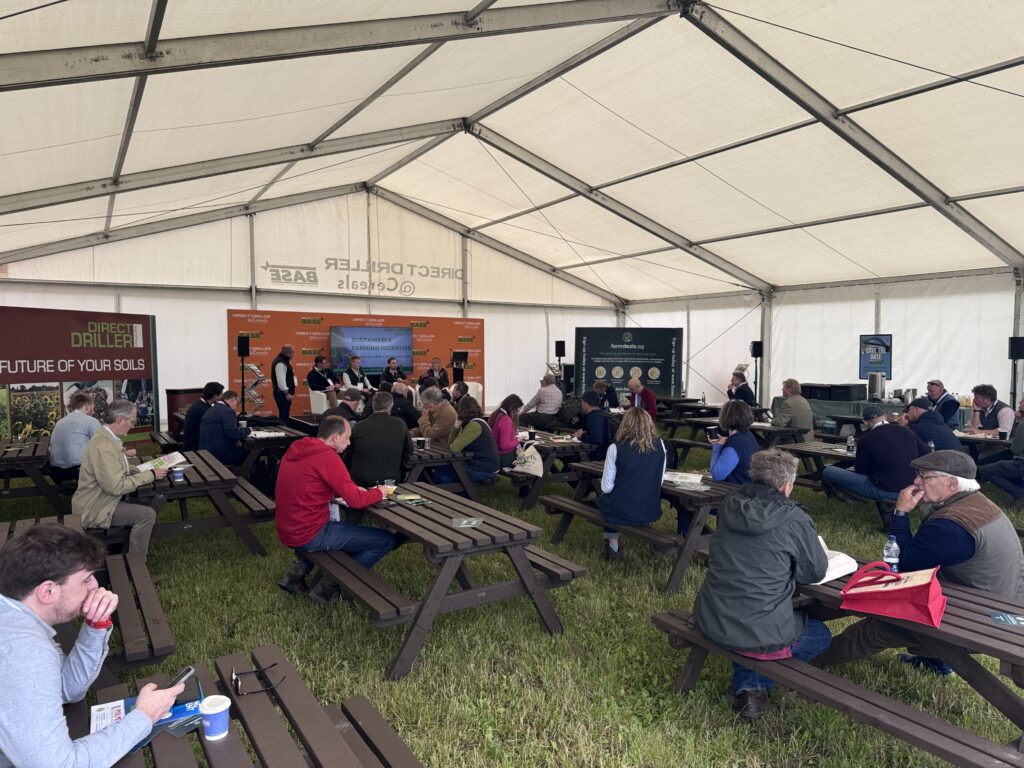The new regen agriculture section at Cereals provided growers the chance to receive advice from well-known regenerative farmers and industry experts. We pick out some of the best tips from a session about the Sustainable Farming Incentive
Written by Mike Abram
How to maximise the benefits from the Sustainable Farming Incentive and make it work for your farm situation were understandably key topics at the regenerative conference arena at Cereals.
While some detail about the new SFI2024 offer was still lacking at the time of the event thanks to the then forthcoming General Election, speakers on each day discussed how to profit from SFI through implementing regenerative farming practices, as well as other stewardship measures.
Here are some of their tips.
- Do your homework
Look for options that could help your farm de-risk, and those that improved and benefited the farm’s most important asset: the soil, suggested Elliot Taylor, a farm business consultant for George F White.
“There are lots of options available – over 100 in SFI24. So is it straightforward? No, the scheme can be complicated, not least because you can have multiple schemes with different timings,” he said.
“It is important to do your homework, and how will it affect you farm business moving forward.”
Think through the impact of options, agreed Cambridgeshire farmer Martin Lines. “For example, the direct drilling payments will lock you into three years of direct drilling a field. Some of our fields will need some tillage on the headlands this year where we’ve made a bit of a mess.
“It’s important to understand where you want to take your business because while you can add more options every season, you can’t remove them [completely] once you’ve signed an agreement.”
Post-Cereals Defra clarified that options can only be added by taking out a new agreement, rather than as an addition to an existing agreement.
On Hope Farm, the farm Georgie Bray manages for RSPB, the direct drilling option wouldn’t necessarily fit because of the need to cultivate in organic matter to fit with Farming Rules for Water.
Keeping nutrients in fields and lose as little into watercourses as possible, as well as looking after the soil were key aims on the farm, she said. “Thinking about what you want to achieve and seeing what options are available to deliver that means we can be more strategic in our approach.”
2. Look at options as fixed or movable assets
Martin is using SFI and other schemes to make the farm’s whole landscape more productive and profitable. Less productive areas have been taken out of production, while fields have been squared by GPS to maintain full combine header widths.
“I’ve looked it as fixed assets and movable assets. Shaded corners, buffering water courses, wet holes and awkward field corners are my fixed assets – they’re going to stay in stewardship, so which options can I use to provide long-term delivery?” he said.
“And then the rotational options – cover crops, herbal leys and legume fallows – are the movable assets.
“Don’t be overly ambitious in the way you use them. If the wheat price goes through the roof, you won’t be able to react if you’ve committed too much to these schemes, as you can only reduce areas by 50% from one year to the next.”
On his farm around 10% is in habitat options, between 10-20% in rotational options, with the rest of the land cropped.
That 10% was a good number, Georgie suggested, with research suggesting that was what was required to help nature recover on farm.
“If you had 2% down of your land down to a winter bird food mix, which is paid well through SFI that’s enough for farmland birds to get through winter and help populations recover, and it’s about 4% for wildflower margins.”
Putting too much of the landscape into wild bird food would provide too much seed and encourage rodents, and in the medium term likely create weed problems, she warned.
“That’s why putting some of these options into rotations and following advice on what percentage you need is the best way to go about this.”
3. Talk to your landlord
Landlords are seeing SFI money as part of their income stream, so discussing what’s involved with them is vital, Martin stresses. “This isn’t free money. BPS was free money, basically – fill a form in, do some cross-compliance. While cross-compliance is staying, there are costs to doing a scheme, which are important to communicate to your landlord.”
It could require a shift in contract types, he suggests. “Where we have contract farming agreements, we’re moving those to share farming agreements because as a contractor I want to be part of the decision-making of how we make profit out of all the farmed landscape.
“I see myself as an asset manager of natural capital. What can we grow crops on? What can we grow bees and butterflies on? Can those bees and butterflies increase my yield, so I don’t need insecticides? We need to stack those options into the business plan, even if it makes things more complicated.”
4. Draw a map for different options and schemes
With the potential for lots of different schemes, agreements and start dates, possibly with different rules and standards to comply with, effective management will be crucial.
One of Martin’s solutions to help his staff and others involved on the farm with the complexity is to draw a map with the options clearly marked so everyone knows what and where each one is happening. “There are some apps that are helpful too.”
One example was an app developed by Hedgelink, Georgie suggested. “In terms of mapping software, there’s the Land App, but I think Google Earth is brilliant. It’s free for everybody to use, easily shareable from your phone.”
She also uses a spreadsheet with a list of what needs doing in which month, which can be used to create task lists for contractors or farm employees.
5. Consider collecting baseline data
Both Martin and Georgie were collecting baseline environmental data, which would help demonstrate improvements over time.
RSPB had set up monitoring programmes for butterflies, bumblebees, and birds which were helping to understand what made most difference, Georgie explained.
Martin had used volunteers doing surveys to obtain similar sorts of data, plus more recently using electronic devices to monitor bird songs. “It’s about understanding what you have on farm. We’re going to have to show the public the value of their money for public goods, and showing how things are improving.”
Currently Martin funds that work himself. “It helps me communicate to policy makers with evidence.”
Defra currently didn’t have a proper baseline to assess whether the actions were delivering on-farm, he suggested. “It is spending money without a known outcome, which is going to be challenging in the near future for the Treasury,” he predicted.
Georgie also agreed that it would be difficult for the government to know what difference was being made, but stressed it was important farmers did use the money to deliver a benefit.
“If we can show, for example, national bird survey trends are improving as a result of SFI that will tick a box for us and hopefully help secure more money in future.”

6. Look at the wider benefits
Options can provide much wider and longer-lasting benefits than just the immediate aim, Martin suggested.
For example, an overwintered cover crop, followed by spring and summer fallows or cover crops, while not providing as much income may help deal with weed issues and provide entry into a cheap, low input first wheat.
“Diverse cover crops have provided 80-120 kg/ha of additional nitrogen, grazing with sheep another 20-40 kgN/ha, and where we’ve included manure up to 260 kgN/ha by improving soil health.
“So don’t look at an option and think I’m going to make X out of it; think about how it will fit into your rotation. We are not going to be paid for doing this forever, so use it to get the farm into as resilient a place as possible over the next three to six years.”
7. Join a farmer cluster
SFI was not likely to be the only opportunity for funding for natural capital, with biodiversity net gain, nutrient neutrality and carbon schemes all at various stages of development.
Before entering into SFI schemes it was worth assessing the farm for areas that could be suitable for those other schemes, Elliot suggested. “It is important to think about those areas and the advantages there potentially could be from those opportunities.”
Keeping in touch with those opportunities was easiest through local farm clusters, Georgie suggested. “The opportunity for bigger funding pots is going to come through farmers working together. Farmer clusters are on the front line for that kind of information, so it is worth getting involved if you have one nearby, not least because it’s hard to keep up to date on your own.”
Realistically, however, there would be relatively little money available for BNG, Martin pointed out. “It will go to unique sites near to a development, so you need to have a watercourse or some other feature in your landscape you can improve through BNG. That money is not coming to all farmers, but you can get SFI funds. Take the money while it is there,” he advised.


